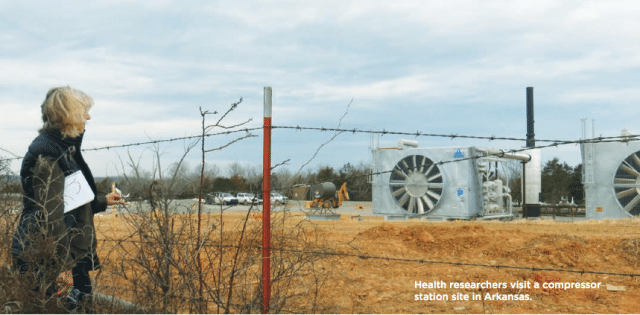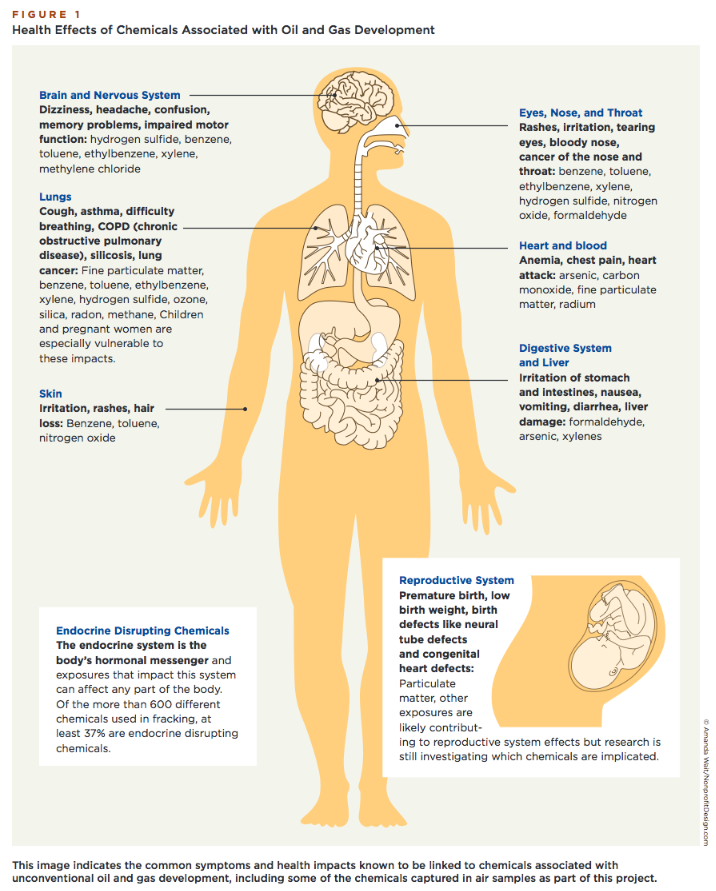The threat posed by fracking to water quality is an issue receiving a lot of attention lately (see here, here, and here, for instance), as is the looming collapse of the fracking boom. But the Center for Environmental Health, suspecting that the whole story wasn’t being told, partnered with 15 different local, state, and national organizations to study fracking’s impact on the air we breathe, and the results are not pretty.
Since 2012, community groups in six states—Arkansas, Colorado, New York, Ohio, Pennsylvania, and Wyoming—have been collecting air samples at oil and gas development sites where horizontal drilling, fracking, and other unconventional drilling and well stimulation techniques were employed.
The results, which were written up in the peer-reviewed journal Environmental Health and are also available in the report “Warning Signs: Toxic Air Pollution Identified at Oil and Gas Development Sites,” were analyzed by CEH and a team of specialists, who describe the results as “shocking.” The key takeaways:
- Fifteen of the 35 “grab” air samples (meaning, where air is intentionally drawn into a sampling device), had concentrations of volatile chemicals that exceeded federal exposure risk levels for cancer, or for non-cancer health effects.
- Fourteen of the 41 passive samples (where air naturally passes through a sampling device) had concentrations of volatile chemicals that exceeded federal exposure risk levels for cancer, or for non-cancer health effects.
- One sample had air pollution levels that may pose an immediate danger to life or health, according to Centers for Disease Control guidelines.
- Benzene, a known human carcinogen, was detected at sample locations in Pennsylvania and Wyoming, in levels exceeding health-based standards by several orders of magnitude.
- In three states, formaldehyde was detected at levels exceeding the health-based standards of the International Agency for Research on Cancer (IARC).
At least 37% of the more than 600 chemicals used in fracking are endocrine disruptors, according to the report. Other health impacts from chemicals associated with oil and gas development include headaches, impaired motor function, asthma, chronic obstructive pulmonary disease, liver damage, heart attacks, and cancers of the lungs, nose, and throat.
The report notes that while these findings are more than enough cause for concern, they still don’t come close to telling the whole story. For one thing, government standards for what constitutes a safe level of toxic air pollution use “working adult men” as their baseline for human health, so the threat posed to infants, children, the elderly, and other vulnerable populations can not easily be assessed. Government standards also fail to account for the effects of cumulative exposure to air pollution, even though we’re hardly at risk only when in the proximity of a fracking operation.
More research is not just warranted, but urgently needed, the report’s authors write: “Understanding the cumulative and life-cycle impacts of oil and gas development is critical to addressing these public health challenges.”
It’s extremely difficult to determine how many fracked oil and gas wells there are in the US, for the simple reason that most states don’t release that data to the public. Some states don’t even require that data be reported by oil and gas companies at all. But according to FracTracker, which has done the difficult work of compiling as much information as possible on unconventional drilling and well stimulation techniques, the U.S. has over 1.1 million active oil and gas wells.
The sheer fact that we can’t ascertain with any certainty when and where fracking and other extreme oil extraction methods like acidization and cyclic steam injection are being used points to one of the most crucial gaps in our knowledge about the impacts of the current shale boom.
For instance, there are about 1.2 million Pennsylvanians living within a half mile of one of the state’s nearly 80,000 oil and gas wells, but there is no reliable information available to them on just what threats they’re facing and how to protect themselves.
And it’s not just environmental and health issues that we need to be concerned about. According to a report by the Natural Resources Defense Council, there are 5.4 million Californians living within a mile of one or more of the 84,000 oil and gas wells in the state. More than a third of them are in communities that are 92% people of color and already “burdened with the worst environmental pollution, as measured by CalEPA’s CalEnviroScreen 2.0.”
In other words, a disproportionate share of the true costs of the fracking boom are being shouldered by those who have always borne the brunt of environmental degradation. Justice will not be served until we know exactly what the risks of fracking are and can all make a free and conscious decision about whether or not we’re willing to pay that price for more oil and gas.
Image Credit: “Health researchers visit a compressor station site in Arkansas” by Elizabeth Crowe
Subscribe to our newsletter
Stay up to date with DeSmog news and alerts








